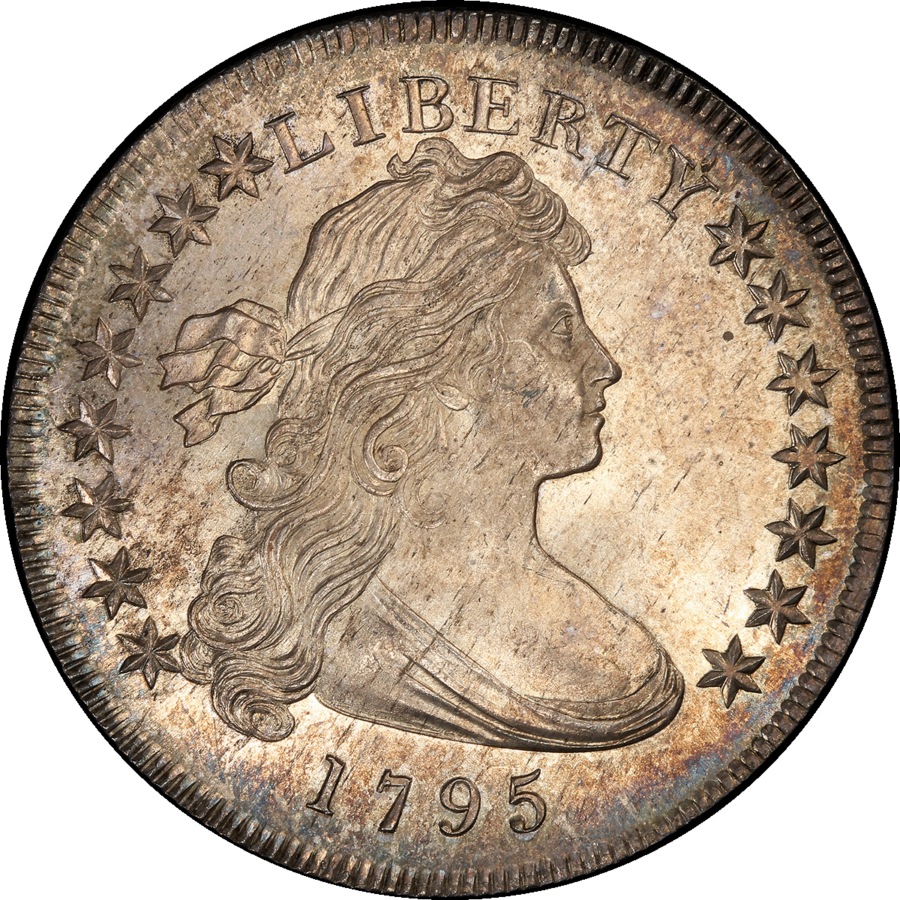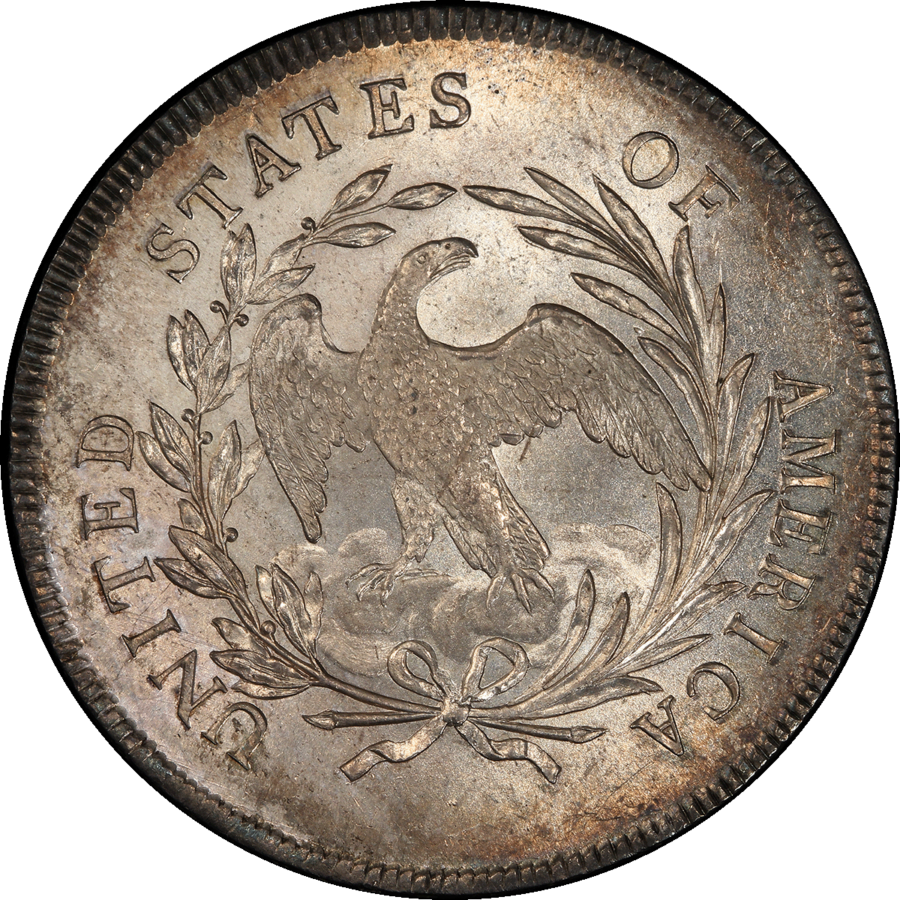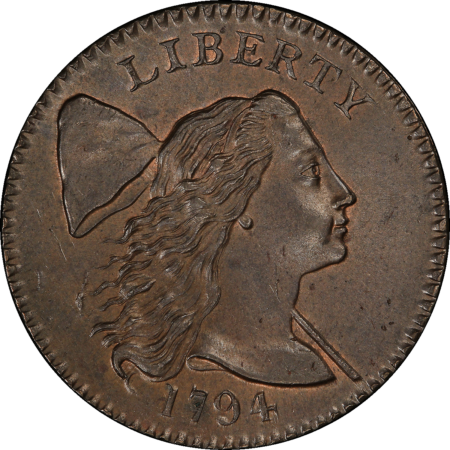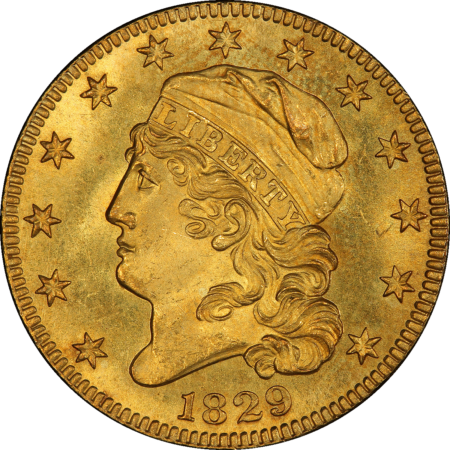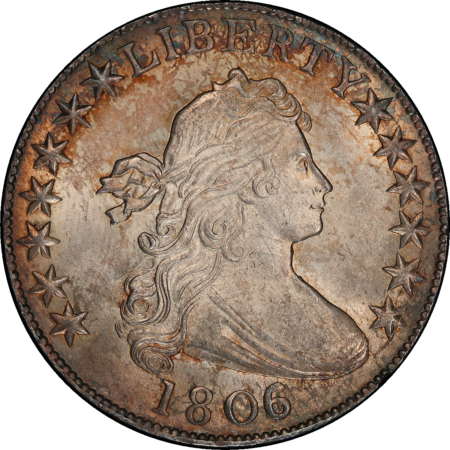Eliasberg's 'Dream Coin' 1795 Draped Bust $1
Bolender 14, Bowers-Borkhardt 51 : Bust left of center, highest wave of hair under B of LIBERTY, star 1 touches curl. Reverse with seven berries on olive branch, including a berry under A of STATES.
Spanish Milled Dollars were the commercial workhorse in Pre-Federal America, were legal tender in the United States until the Coinage Act of 1857, and they remained a favorite international trade coin well into the 19th Century. The first truly American dollars appeared in 1794, however, it wasn’t until 1795 that silver dollars were produced in enough quantity to occupy any significant position in American commercial channels.
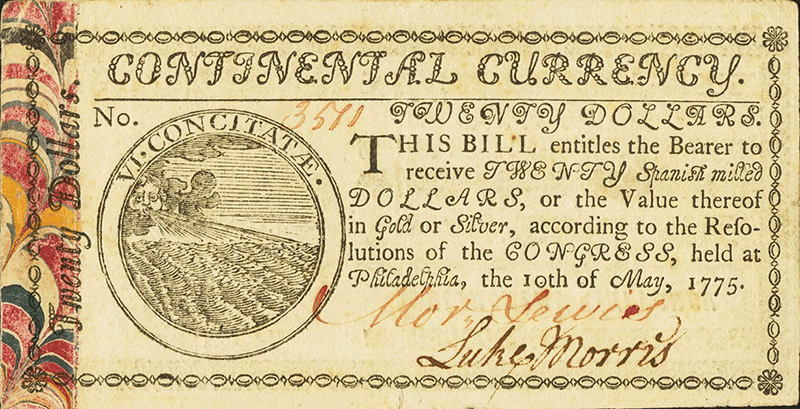
1795 was a transitional year for the dollar denomination, as the last year of the Flowing Hair and the first year for Draped Bust types. 1795 Flowing Hair Dollars were struck from ten obverse dies and eleven reverse dies in nineteen die marriages, while 1795 Draped Bust Dollars are known from two obverses and two reverses paired in only two die marriages. Mintages for 1795-dated Dollars are not known, as obverse dies were regularly used in years past their nominal dates. However, the survival rates and estimated relative mintages of 1795 Flowing Hair versus Draped Bust Dollars is roughly three to one.
In the upper levels of Mint State, the relative rarity of the 1795 silver dollar types tightens, with both PCGS and CAC reporting numbers of 1795 Flowing Hair and Draped Bust Dollars roughly three-to-two in grades MS64 or better. Additionally, there is a crowd of 1795 Flowing Hair Dollars reported by PCGS certified as MS64 while the bulk of 1795 Draped Bust Dollars certified by PCGS as ‘Mint State’ are in the MS63 column. In reality, there is a significant amount of duplication in these numbers, as well as a couple of exceptional NGC certified coins from the Eric Newman Collection which have never been submitted to PCGS. Finally, unfortunately, a review of the actual coins shows a substantial portion of the upper grade 1795 Draped Bust Dollars which show toning that is at least questionable, if not artificial. This leaves us to consider the coins themselves, outside of the picture painted by population statistics.
The three finest 1795 Draped Bust Dollars are all from the B.14 die pair commonly known as ‘Off Center Bust’, with the obverse device left of center. At the top is this remarkable PCGS MS66, formerly in the Clapp and Eliasberg collections, and certified by NGC as MS67 prior to 2003.
Next best is arguably the former Garrrett Collection coin, certified by PCGS as SP66 #11777143. The designation as a ‘Specimen’ is used for a coin intentionally produced at a higher standard and with special care, but before the formal production of coins that we consider to be ‘Master Coins’ or ‘Proof’ strikings beginning in 1818. However, there is no general agreement on this coin’s status as a ‘Specimen’, and it is my opinion that it should be more correctly considered as a Prooflike Gem. The second place ranking is due to its natural second toning, which has darkened a bit since its sale as part of the Jimmy Hayes Collection in 1985. The Garrett 1795 Draped Bust Dollar holds the record price for the issue, last selling for $1,057,500 at the Stack’s Bowers May 2016 sale of the ‘D. Brent Pogue Collection, Part IV’ to a prominent California collector.
Following closely behind is the Newman NGC MS66+ which last sold in November 2013 at $910,625. The Newman B.14 is an unquestionably Gem coin with pearlescent luster over much of the coin, but with an unusual and irregular patch of multi-colored toning above the date and into the right field. There is no question about the Gem status of the Newman coin, but the irregular toning pattern is not for everyone, and arguably pushes this one into third place.
The B.15 die pair is known as the ‘Centered Bust’, as the obverse device is more horizontally balanced within the obverse field. The finest known B.15 ‘Centered Bust’, and likely overall fourth best 1795 Draped Bust $1 is the Davis-Pogue PCGS MS66 which last sold publicly at the Stack’s Bowers May 2016 Pogue IV auction to Oliver Jung at $646,250. It then resold privately in 2019 for a touch more to a prominent Utah collector.
Rounding out the top five is another example of the B.15 Centered Bust die pair, formerly in Walt Hood’s personal collection, and most recently offered as part of the Bob Simpson Collection as PCGS MS65+, selling for $456,000 at Heritage Auctions sale of November 2020. The Simpson MS65+ has obviously been ‘dipped’ to an artificial silvery white and is lightly hairlined, which may push it outside of the Gem category for some buyers.
In Jules Reiver’s 1999 revision of Bolender’s “The United States Early Silver Dollars 1794 to 1803”, John J. Haugh writes about “Some Observations About Early Dollars” :
“Neither I, nor any specialist I know, has ever seen a perfect one (akin to a Morgan graded MS68), although the Eliasberg 1795 Draped Bust sold in 1997 was awesome.”
In Q. David Bowers’s 2013 “The Encyclopedia of United States Silver Dollars 1794-1804”, he writes of the Eliasberg 1795 Draped Bust $1 :
“Superbly, indeed, incredibly sharply struck, the very definition of the design. Brilliant surfaces with just a whisper of golden toning.This piece is certainly one of the very finest in existence of any issue in the entire Draped Bust series. Believed to be the very finest known specimen of 1795 BB-51, an incredibly important coin from the aspect of its preservation and also its numismatic and historical importance.”
An article in ARTnews dated December 18, 2020 by collector Leonard Lauder entitled ‘You Only Regret What You Don’t Buy’ : Leonard Lauder on His Life as an Art Collector includes an excerpt from his recent memoir “The Company I Keep: My Life in Beauty“:
“The development of the uneducated, untutored eye is a journey. You go from liking the good to appreciating the better to loving the best. My brother Ronald, one of the great collectors of our time, codified his approach to collecting into what he calls “the three O’s”: Oh! Oh, my! Oh, my God!!! His rule: “Only go for the third ‘O.’” The third “O” ensures that every piece is the best it can be.”
This is one of those rare, ‘third O’ coins, the ones that imprint themselves on your memory and don’t allow you to forget them. That was my experience watching Brent Pogue buy this coin in July 2002. Certainly, I had seen the coin prior to the Eliasberg sale in April 1997, but with so many great coins in that sale, it was easy to be overwhelmed, to have other priorities. Five years later, without distraction, it was clear that this was one of the all time great Draped Bust Dollars. The sale of this coin haunted me, as the Pogue Family Collection was seen as a numismatic black hole, a place where coins went in but never came out. That is, until the surprise announcement by Stacks Bowers of the sale of the D. Brent Pogue Collection.
It was clear to me that I just had to have this coin. Luckily, against my advice, Oliver and Lish Jung preferred the Pogue B.15 ‘Centered Bust’, while others were focused upon the prooflike Garrett coin. The prices in Pogue III were mostly a train wreck, and Pogue IV, while an improvement, was still weak, as most buyers were uncertain. Regardless of anything else that I bought that night, the Eliasberg 1795 Draped Bust $1 was my prize.
Including the Pogue sales and the more recent sale of the Bruce Morelan Collection of Early Dollars in 2020, we have had a chance to review nearly all of the great Draped Bust Dollars, including the Garrett 1795 B.14 PCGS SP66 noted above, the 1796 B.2 Small Date Small Letters PCGS/CAC MS65, Amon Carter’s deeply prooflike Gem 1801 B.4 PCGS MS65, the Stickney – Clapp – Eliasberg 1802 B.6 ‘Narrow Date’ PCGS/CAC MS65, and of course, Eric Newman’s incredible 1803 B.6 ‘Large 3’ PCGS/CAC MS65. However, while Newman’s 1803 comes closest, there is no match for Eliasberg’s 1795 Draped Bust $1.
The striking detail of the Eliasberg 1795 Draped Bust $1 is unmatched by any other example of this type. In direct comparison with the Garrett “Specimen”, the Eliasberg B.14 …
PCGS #11777144
Provenance
George H. Earle, Jr.; Henry Chapman ‘George H. Earle, Jr. Collection‘, June 1912, lot 2683; John H. Clapp; Stack’s, private sale, 1942 to Louis E. Eliasberg, Sr.; Bowers and Merena ‘Louis E. Eliasberg, Sr. Collection‘, April 1997, lot 2173 @ $308,000; Bowers and Merena, July 2002, lot 427 @ $345,000 as NGC MS67 to Brent Pogue; Pogue Family Collection; Stacks Bowers ‘D. Brent Pogue Collection, Part IV’, May 2016, lot 4013 @ $763,750 to Joseph O’Connor (OCNUMIS); privately, August 2016 to Bruce Morelan; Bruce Morelan Collection of Early Dollars; Legend Auctions, November 2020, lot 13 @ $705,000 as PCGS MS66 #11777144 to Joseph O’Connor (OCNUMIS).

